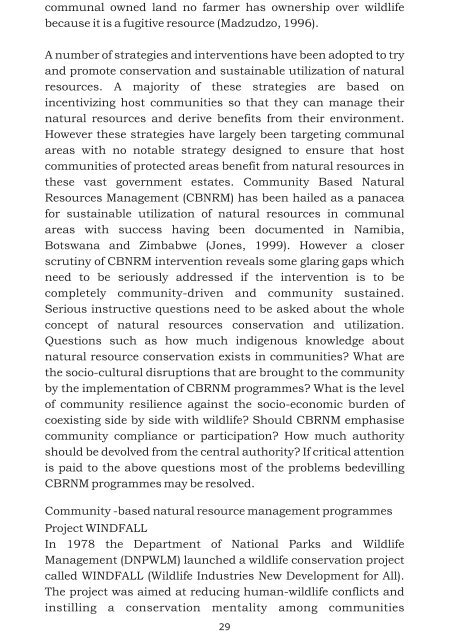Beneficiaries are actors too.pdf - Southern Institute of Peace ...
Beneficiaries are actors too.pdf - Southern Institute of Peace ...
Beneficiaries are actors too.pdf - Southern Institute of Peace ...
You also want an ePaper? Increase the reach of your titles
YUMPU automatically turns print PDFs into web optimized ePapers that Google loves.
communal owned land no farmer has ownership over wildlife<br />
because it is a fugitive resource (Madzudzo, 1996).<br />
A number <strong>of</strong> strategies and interventions have been adopted to try<br />
and promote conservation and sustainable utilization <strong>of</strong> natural<br />
resources. A majority <strong>of</strong> these strategies <strong>are</strong> based on<br />
incentivizing host communities so that they can manage their<br />
natural resources and derive benefits from their environment.<br />
However these strategies have largely been targeting communal<br />
<strong>are</strong>as with no notable strategy designed to ensure that host<br />
communities <strong>of</strong> protected <strong>are</strong>as benefit from natural resources in<br />
these vast government estates. Community Based Natural<br />
Resources Management (CBNRM) has been hailed as a panacea<br />
for sustainable utilization <strong>of</strong> natural resources in communal<br />
<strong>are</strong>as with success having been documented in Namibia,<br />
Botswana and Zimbabwe (Jones, 1999). However a closer<br />
scrutiny <strong>of</strong> CBNRM intervention reveals some glaring gaps which<br />
need to be seriously addressed if the intervention is to be<br />
completely community-driven and community sustained.<br />
Serious instructive questions need to be asked about the whole<br />
concept <strong>of</strong> natural resources conservation and utilization.<br />
Questions such as how much indigenous knowledge about<br />
natural resource conservation exists in communities? What <strong>are</strong><br />
the socio-cultural disruptions that <strong>are</strong> brought to the community<br />
by the implementation <strong>of</strong> CBRNM programmes? What is the level<br />
<strong>of</strong> community resilience against the socio-economic burden <strong>of</strong><br />
coexisting side by side with wildlife? Should CBRNM emphasise<br />
community compliance or participation? How much authority<br />
should be devolved from the central authority? If critical attention<br />
is paid to the above questions most <strong>of</strong> the problems bedevilling<br />
CBRNM programmes may be resolved.<br />
Community -based natural resource management programmes<br />
Project WINDFALL<br />
In 1978 the Department <strong>of</strong> National Parks and Wildlife<br />
Management (DNPWLM) launched a wildlife conservation project<br />
called WINDFALL (Wildlife Industries New Development for All).<br />
The project was aimed at reducing human-wildlife conflicts and<br />
instilling a conservation mentality among communities<br />
29


